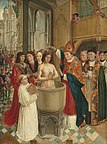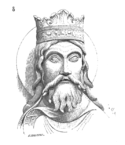Clovis I
| Clovis I | |
|---|---|
 Baptism of Clovis, ivory book cover from c. 870 | |
| King of the Franks | |
| Reign | c. 509 – 27 November 511 |
| Successor | See list |
| King of the Salian Franks | |
| Reign | c. 481 – 509 |
| Predecessor | Saint-Denis Basilica |
| Spouse | Clotilde |
| Issue | |
Merovingian | |
| Father | Childeric I |
| Mother | Basina of Thuringia |
| Religion | Initially Frankish paganism, but converted to Chalcedonian Christianity |
Clovis (
Clovis succeeded his father,
Clovis is also significant because of his
Name
Based on the attested forms, the original name is reconstructed in the
However, scholars have pointed out that
In
The Frankish name *Hlodowig is at the origin of the French given name
Background
Clovis was the son of
Numerous small Frankish
Childeric I, Clovis's father, was reputed to be a relative of Chlodio, and was known as the king of the Franks that fought as an army within northern Gaul. In 463 he fought in conjunction with
The death of
Though no primary sources expounding on the language spoken by Clovis exist, historical linguists consider it likely that, based on his family history and core territories, he spoke a form of
Early reign (481–491)
Road to Soissons
The
Taming Gaul
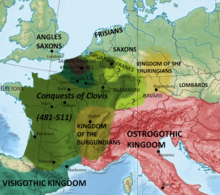
Prior to the battle, Clovis did not enjoy the support of the Gallo-Roman clergy, so he proceeded to pillage the Roman territory, including the churches. The Bishop of Reims requested Clovis return everything taken from the Church of Reims; the young king aspired to establish cordial relationships with the clergy, so he returned a valuable ewer taken from the church.[18] Despite his position, some Roman cities refused to yield to the Franks, namely Verdun ‒ which surrendered after a brief siege ‒ and Paris, which stubbornly resisted a few years, perhaps as many as five.[13] He made Paris his capital[19] and established an abbey dedicated to Saints Peter and Paul on the south bank of the Seine.[20]
Realizing that he would not be able to rule Gaul without the help of the clergy, Clovis took a Nicene Christian wife to please them.
Middle reign (492–506)
Barbarian bonding
Around 493 AD, he secured an alliance with the Ostrogoths through the marriage of his sister Audofleda to their king, Theodoric the Great.[19] In the same year, the neighboring King of the Burgundians was slain by his brother, Gundobad; bringing civil strife to that kingdom. Allegedly, Gundobad proceeded to drown his sister-in-law and force his niece, Chrona, into a convent. Another niece, Clotilde, fled to the court of the third brother, Godegisel. Finding himself in a precarious position, Godegisel decided to ally himself to Clovis by marrying his exiled niece to the Frankish king.[22]
Assault of the Alamanni
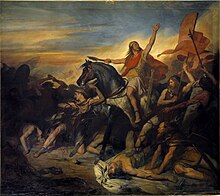
In 496, the
Business in Burgundy
In 500 or 501, Godegisel began scheming against his brother Gundobad. He promised his brother-in-law territory and annual tribute for defeating his brother. Clovis was eager to subdue the political threat to his realm and crossed into the Burgundian territory. Gundobad then moved against Clovis and called his brother for reinforcements. The three armies met near Dijon, where both the Franks and Godegisel's forces defeated the dumbfounded Gundobad, who escaped to Avignon. Clovis pursued him and laid siege to the city. After some months, Clovis was convinced to abandon the siege and settled for an annual tribute from Gundobad.[24]
Armorici allies
In 501, 502 or 503, Clovis led his troops to Armorica. He had previously restricted his operations to minor raids, but now the goal was subjugation. Clovis failed to complete this objective via military means; therefore, he was constrained to statecraft. This proved fruitful, for the Armonici shared Clovis's disdain for the Arian Visigoths. Armorica and its fighters were thus integrated into the Frankish realm.[25]
Late reign (507–511)
Visiting the Visigoths

In 507 Clovis was allowed by the magnates of his realm to invade the remaining threat of the Kingdom of the Visigoths. King Alaric had previously tried to establish a cordial relationship with Clovis by serving him the head of exiled Syagrius on a silver plate in 486 or 487. However, Clovis was no longer able to resist the temptation to move against the Visigoths, for many Nicene Christians under Visigoth yoke were unhappy and implored Clovis to make a move. But just to be absolutely certain about retaining the loyalties of the Nicene Christians under Visigoths, Clovis ordered his troops to omit raiding and plunder, for this was not a foreign invasion, but a liberation.[26]
Armorici assisted him in defeating the Visigothic kingdom of Toulouse in the Battle of Vouillé in 507, eliminating Visigothic power in Gaul. The battle added most of Aquitaine to Clovis's kingdom[19] and resulted in the death of the Visigothic king Alaric II.
According to Gregory of Tours, following the battle the
Unifying the Franks
Following the Battle of Vouillé, Clovis eliminated all his possible rivals, including the other Frankish kings that ruled alongside him.
Sometime after 507, Clovis heard about Chararic's plan to escape from his monastic prison and had him murdered.[16] Around the same time, Clovis convinced Prince Chlodoric to murder his father Sigobert, earning him his nickname as "Chlodoric the Parricide". Following the murder, Clovis betrayed Chlodoric and had his envoys strike him down.[28] Sometime later, Clovis visited his old ally Ragnachar in Cambrai. Following his conversion to Christianity in 508, many of Clovis' pagan retainers had defected to Ragnachar's side, making him a political threat.[24] Ragnachar denied Clovis's entry, prompting Clovis to make a move against him. He bribed Ragnachar's retainers and executed him alongside his brother Ricchar.[29]
Death

Shortly before his death, Clovis called a synod of Gallic bishops to meet in
His remains were relocated to
The disunity continued under the
Baptism
Clovis was born a pagan but later became interested in converting to
Clovis's wife
The king's Nicene baptism was of immense importance in the subsequent history of Western and Central Europe in general, as Clovis expanded his dominion over almost all of Gaul. Nicene Christianity offered certain advantages to Clovis as he fought to distinguish his rule among many competing power centers in Western Europe. His conversion to the Nicene form of Christianity served to set him apart from most other Germanic kings of his time, such as those of the
On the other hand,
Clovis and his wife were buried in the
Roman law
Under Clovis, the first codification of the Salian Frank law took place. The Roman Law was written with the assistance of Gallo-Romans to reflect the Salic legal tradition and Christianity, while containing much from Roman tradition. The Roman Law lists various crimes as well as the fines associated with them.[39]
Legacy
The legacy of Clovis's conquests, a Frankish kingdom that included most of Roman Gaul and parts of western Germany, survived long after his death.[40] To the French people, he is the founder of France.
Detracting, perhaps, from this legacy, is his aforementioned division of the state. This was done not along national or even largely geographical lines, but primarily to assure equal income amongst his sons after his death. While it may or may not have been his intention, this division was the cause of much internal discord in Gaul. This precedent led in the long run to the fall of his dynasty, for it was a pattern repeated in future reigns.[41] Clovis did bequeath to his heirs the support of both people and Church such that, when the magnates were ready to do away with the royal house, the sanction of the Pope was sought first.
- Images of the King
-
Saint Remigius baptizes Clovis, in a painting of c. 1500
-
Clovis statue at the AbbeyChurch of Saint-Denis
-
The Sons of Clovis, by Georges Moreau de Tours (1877)
Sainthood
King Saint Clovis | |
|---|---|
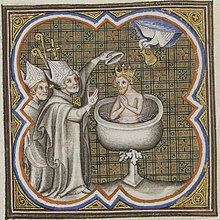 | |
| King and New Constantine | |
| Born | c. 466 Tournai |
| Died | 27 November 511 Paris |
| Venerated in | Catholic Church in France and Southern Italy |
| Major shrine | Basilica of Saint-Denis; Abbey of Saint Genevieve; Moissac Abbey |
| Feast | 27 November (France),[42]: 497 26 October (Southern Italy)[43]: 39 |
| Attributes | suit-of-armour; upright sword; fleur-de-lis; three frogs (his attributed arms) |
| Patronage | France[44]: 25 |
| Controversy | Lack of papal approval; debated violent character; interference from the French state. |
In later centuries, Clovis was venerated as a saint in France. The
It has been suggested that the reason that the French state promoted the veneration of Clovis in the south was to establish a border cult that would cause
St. Clovis had the role of a more militarised royal saint than the pious
St. Clovis had no known official
The Jesuit attempt to formally canonize Clovis came after a rediscovery of Clovis's cultus in the 16th century. During this period, the dual role St. Clovis could have for modern France was clarified as that of a deeply sinful man who attained sainthood by submitting himself to the will of God, as well as being the founder of the Gallican Church.[58]: 154–155 He also attained an essentially mystic reputation.[58]: 154 St. Clovis' role in calling for the First Council of Orléans was understood to be strongly Gallican as he called it without Papal authority and with the understanding that he and his bishops had the authority to call councils that were binding for the Frankish people.[58]: 157 For Protestant Gallicans, St. Clovis represented the role of the monarchy in governing the Church and curbing its abuses and was contrasted positively against the Papacy of his time.[58]: 155 Protestants were unlikely to mention any of the miracles attributed to St. Clovis, sometimes even writing lengthy rejections of their existence.[58]: 158 Instead, they saw his sainthood as evident from his creation of a state more holy and Christian than that of Rome.[58]: 158
Catholic writers in the 16th century expanded upon the lists of St. Clovis's attributed miracles, but in the early 17th century they also began to minimize their use of the miraculous elements of his hagiography.
Chronology
The sole source for the early Frankish period is Gregory of Tours, who wrote around the year 590. His chronology for the reign of Clovis is almost certainly fabricated, often contradicting itself and other sources.[59][60] Gregory often divides Clovis' life in spans of 5 years: he became king at age 15, defeated Syagrius in the 5th year of his reign, defeated the Alamanni in his 15th year, defeated the Visigoths in his 25th year, and died at the age of 45, in the 5th year after his victory at Vouillé, having reigned 30 years.[59][61] The exact date on which Clovis became "king of all Franks" is not known, but it happened sometime after the Battle of Vouillé, which is securely dated to 507.[62] After this battle, Clovis made Paris his capital, converted to Catholicism, and orchestrated the murders of Frankish kings Sigobert and Ragnachar, uniting all Franks under his rule.[61]: 38–43 Clovis' baptism, traditionally dated to December 496 on the account of Gregory, is now believed to have taken place in December 508.[4][63][59] The election of Paris as capital must have also happened around 508.[64] Given that the hostilities between Ragnachar and Clovis began after his conversion,[24] it can be inferred that their confrontation took place shortly after, in 509. [29]
Clovis I is traditionally said to have died on 27 November 511.
References
Footnotes
- ^ a b Chisholm, Hugh, ed. (1911). . Encyclopædia Britannica. Vol. 6 (11th ed.). Cambridge University Press. pp. 563–564.
- ^ Brown, Peter (2003). The Rise of Western Christendom. Malden, MA: Blackwell Publishing Ltd. p. 137.[ISBN missing]
- ^ General Charles de Gaulle is cited (in the 1965 biography by David Schoenbrun), as having said "For me, the history of France begins with Clovis, elected as king of France by the tribe of the Franks, who gave their name to France. Before Clovis, we have Gallo-Roman and Gaulish prehistory. The decisive element, for me, is that Clovis was the first king to have been baptized a Christian. My country is a Christian country and I reckon the history of France beginning with the accession of a Christian king who bore the name of the Franks." (Pour moi, l'histoire de France commence avec Clovis, choisi comme roi de France par la tribu des Francs, qui donnèrent leur nom à la France. Avant Clovis, nous avons la Préhistoire gallo-romaine et gauloise. L'élément décisif pour moi, c'est que Clovis fut le premier roi à être baptisé chrétien. Mon pays est un pays chrétien et je commence à compter l'histoire de France à partir de l'accession d'un roi chrétien qui porte le nom des Francs.)
- ^ S2CID 161819012.
- ^ ISBN 978-90-04-05436-3.
- ^ a b Zheltukhina, Marina R.; Vikulova, Larisa G.; Vasileva, Gennady G. Slyshkin & Ekaterina G. (2016). "Naming as Instrument of Strengthening of the Dynastic Power in the early middle Ages (France, England, Vth –XIth Centuries)". International Journal of Environmental and Science Education: 7200–7202.
- ^ Julius Pokorny (1959), Indogermanisches Etymologisches Wörterbuch, Bern.
- ^ Nederlandse Voornamenbank, Lodewijk, Royal Netherlands Academy of Arts and Sciences, Meertens Institute.
- Meertens Instituut, Nederlandse Voornamenbank, Lodewijk. The second element corresponds to Middle High German wîc, with final-obstruent devoicing, as in Ludewic. The Middle Dutch form is wijch (modern Dutch wijg; see WNT, "wijg"), as in original Dutch Hadewig, Hadewijch.
- ^ ISBN 978-3-11-017470-0.
- ^ "Lewis". Online Etymology Dictionary.
- ^ Rosenwein, Barbara (2004). A Short History of the Middle Ages. Canada: University of Toronto Press. p. 43.[ISBN missing]
- ^ a b c d e Bachrach 1972, pp. 3–4.
- ^ Jelle Stegeman: Grote geschiedenis van de Nederlandse taal, Amsterdam 2021, §3.1.1.1.
- ^ Einhard, Vita Karoli 25. & Janet Nelson: King and Emperor. London 2019, pp. 68.
- ^ a b c d The Cambridge Medieval History, Vol. 2, (Henry Melvill Gwatkin et al, eds.), Macmillan, 1913, p. 110
- ^ Frassetto, Michael, Encyclopedia of barbarian Europe, (ABC-CLIO, 2003), p. 126
- ^ a b Bachrach 1972, p. 8.
- ^ a b c d "Iron Age Braumeisters of the Teutonic Forests". BeerAdvocate.
- The Panthéon, and the parish Saint-Étienne-du-Mont, which was built on the abbey territory.
- ^ Bachrach 1972, p. 5.
- ^ . Encyclopædia Britannica. Vol. 6 (11th ed.). 1911. p. 557.
- ^ Bachrach 1972, p. 6.
- ^ a b c Bachrach 1972, p. 9.
- ^ Bachrach 1972, p. 10.
- ^ Bachrach 1972, p. 3–11.
- ISBN 978-1-61451-099-4.
- ^ Howorth, H.H., "The Ethnology of Germany", The Journal of the Anthropological Institute of Great Britain and Ireland, Volume 13, Anthropological Institute of Great Britain and Ireland, 1884, p. 235
- ^ a b Bachrach 1972, p. 31.
- ^ Patrick Boucheron, et al., eds. France in the World: A New Global History (2019) pp 85–86.
- ^ Ian Wood, The Merovingian Kingdoms, (Longman, 1994), 45.
- ^ Geary, Patrick (2003). Readings in Medieval History: Gregory of Tours History of the Franks. Canada: Broadview Press Ltd. pp. 145–146.
- ^ James Muldoon, (ed.) (1997). Gender and Conversion in the Merovingian Era, Cordula Nolte, Varieties of Religious Conversion in the Middle Ages, University of Florida Press, p. 88
- ISBN 978-0-19-822543-0.
- ^ Robinson, J.H. (1905). Readings in European History. Boston. pp. 51–55.
{{cite book}}: CS1 maint: location missing publisher (link) - ^ James, Edward (1985) Gregory of Tours: Life of the Fathers. Liverpool: Liverpool University Press; p. 155 n. 12
- ^ Daly, William M., "Clovis: How Barbaric, How Pagan?" Speculum 69.3 (July 1994:619–664)
- ^ Geary, Patrick (2003). Readings in Medieval History: Gregory of Tours History of the Franks. Canada: Broadview Press Ltd. p. 153.
- ^ Geary, Patrick (2003). Readings in Medieval History:Rome Law. Canada: Broadview Press Ltd. pp. 129–136.
- ^ Rickard, J (1 January 2013), Clovis I, King of the Franks, r. 481–511
- ^ "The Rise of the Carolingians or the Decline of the Merovingians?" (pdf)
- ^ a b c Lombard-Jourdan, Anne. L’invention du "roi fondateur" à Paris au XIIe siècle : de l’obligation morale au thème sculptural. Bibliothèque de l’école des chartes (1997): 485-542.
- ^ Sacro Regio Consiglio (S.R.C.) del Regno di Napoli, Notiziario ragionato del Sacro Regio Consiglio e della Real Camera di s. Chiara
- ^ Breuilly, John The Oxford Handbook of the History of Nationalism
- ^ Penman, Michael, and Erica Carrick Utsi. In Search of the Scottish Royal Mausoleum at the Benedictine Abbey of Dunfermline, Fife: Medieval Liturgy, Antiquarianism, and a Ground-Penetrating Radar Pilot Survey, 2016–19.
- ^ a b Jansen, Philippe. La part du Midi dans la naissance de la nation française: Beaune (Colette), Naissance de la Nation France, Paris, Gallimard, Bibliothèque des Histoires, 1985. Annales du Midi. Vol. 99. No. 177. Privat, 1987.
- ^ a b c Remensnyder, Amy Goodrich Remembering Kings Past: Monastic Foundation Legends in Medieval Southern France
- ^ a b c Krynen, Jacques. «Qu'est-ce qu'une nation?» La réponse médiévale française. Revue historique de droit français et étranger (1922–) 64.1 (1986): 71–78.
- ^ Renna, Thomas. Saint Louis IX and Holy Roman Emperor Frederick III. Expositions 9.2 (2015): 35–79.
- ^ a b Ruddick, Andrea English Identity and Political Culture in the Fourteenth Century
- ^ a b Lloberah, Josep R.The God of Modernity: The Development of Nationalism in Western Europe
- ^ "Print; book-illustration | British Museum".
- ^ von Chlingenberg, M. Das Königreich Bayern in seinem alterthümlichen, geschichtlichen, artistischen und malerischen Schönheiten, in einer Reihe von Stahlstichen mit begleitendem Texte. Vol. 3. Georg Franz, 1854.
- ^ Brown, Thomas The Reminiscences of an Old Traveller Throughout Different Parts of Europe
- ^ Lee, Edwin Bradshaw's companion to the Continent
- ^ a b Grell, Chantal Le baptême de Clovis aux XVIIe et XVIIIe siècles. Versalia. Revue de la Société des Amis de Versailles 1.1 (1998): 48–59.
- ^ Koopmans, Jelle. Le Mystere de Saint Remi
- ^ a b c d e f g h i j k Yardeni, Myriam. "Le christianisme de Clovis aux XVI e et XVII e siècles." Bibliothèque de l’École des chartes (1996): 153–172.
- ^ ISBN 978-1-61451-099-4.
- ISBN 978-90-04-17999-8.
- ^ a b c d Gregory of Tours, Book II
- ISBN 978-1-61451-099-4.
- ISBN 978-1-57258-631-4.
- ISBN 978-1-59051-942-4.
- ^ a b Auguste Molinier (1902). Obituaires de la province de Sens. I, p. xiv, 306, 631.
- ISBN 978-88-374-1465-8.
- ISBN 978-1-137-01428-3.
Sources
- Bachrach, Bernard S. (1972). Merovingian Military Organization, 481–751. University of Minnesota Press. ISBN 978-0816657001.
- Daly, William M. (1994) "Clovis: How Barbaric, How Pagan?" Speculum, 69:3 (1994), 619–664
- James, Edward (1982) The Origins of France: Clovis to the Capetians, 500–1000. London: Macmillan, 1982
- Kaiser, Reinhold (2004) "Das römische Erbe und das Merowingerreich", in: Enzyklopädie deutscher Geschichte; 26. Munich (in German)
- Oman, Charles (1914) The Dark Ages 476–918. London: Rivingtons
- Wallace-Hadrill, J. M. (1962) The Long-haired Kings. London


